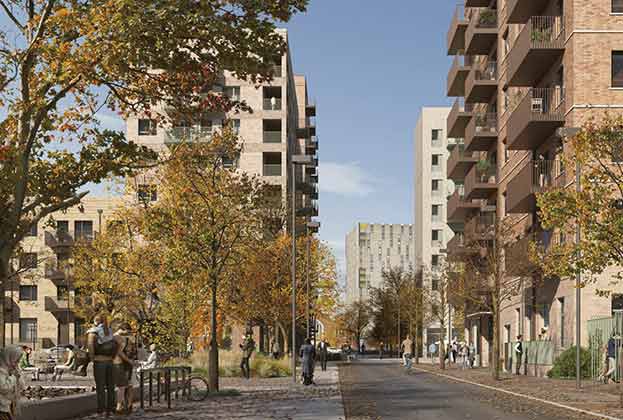The implications of East London Corridor’s current undersupply
MHCLG recorded 41,720 net additional homes across London, in the year to March 2020, some 10,000 short of the new London Plan target, which is 52,000. This level of delivery is also less than half of the 93,500 required under the government’s new standard method of calculating housing need. Statistics from Molior show that new construction starts in London have decreased for the third successive year in 2020 and were -36% below 2017 levels. This indicates that the undersupply of homes in London is set to continue.
Boroughs in the East London Corridor among the most undersupplied in London
In the new London Plan, housing targets increased most significantly in outer London boroughs, and the latest delivery figures show all East London Corridor boroughs are currently delivering fewer homes than their London Plan target. Havering, Barking and Dagenham and Redbridge make up three of the four lowest delivering boroughs (as a proportion of their targets). Tower Hamlets and Newham have delivered the most housing over the last three years of any London borough, but they are both still falling short, both delivering 78% of their target.
The East London Corridor is expected to deliver proportionally more homes than the area of London it covers – 26% of the London Plan’s target whilst making up just 20% of London’s area. Currently, the East London Corridor is delivering 64% of its target, significantly underperforming compared to the rest of London (72%).
There is a clear need to ramp up housing delivery across the capital, but none more so than in London’s eastern corridor. The four outer-most east London boroughs combined are currently delivering just 42% of the targets set out in the London Plan. The Secretary of State has said he will be looking to work with ambitious boroughs who aim to deliver above their housing targets. This presents a significant opportunity for developers to work closely with these boroughs to help bring housing delivery up to where it needs to be, potentially through intensification and high-density development in well-connected areas.
The Housing Delivery Test measurement is an annual measurement of housing delivery. 2020’s results saw Havering, Redbridge, Barking and Dagenham and Tower Hamlets fail to deliver 75% of their requirement, and this has now triggered a presumption in favour of sustainable development. These local authorities must now give greater weight to the government’s National Planning Policy Framework than their local policies on sites that aren’t included in an updated local plan.
Where this positive presumption applies, local authorities must now grant planning permission for proposals which accord with an up-to-date development plan, without delay. They must also grant permission where there are no relevant or up-to-date plan policies, unless specific National Planning Policy Framework policies protecting areas or assets provide a clear reason for refusal or there are adverse impacts that outweigh the benefits of the proposal.
Green Belt constraints present opportunities for London’s surrounding local authorities
In Havering and Redbridge, where delivery levels were lowest, there are significant constraints from the Green Belt, with 53% and 34% of land area covered by the Green Belt respectively. Only Bromley, Hillingdon and Enfield also see greater than 30% of their land area covered by Green Belt, but lower housing requirements mean only 0.08 homes are required each year per hectare of non-Green Belt land in Bromley and Hillingdon, and 0.15 in Enfield. With more homes required per hectare of non-Green Belt land in the East London Corridor (see table below), boroughs will need to look to high-density development or review the Green Belt to deliver the homes required.
There may also be a role to play for areas outside London’s boundary in alleviating the pressures of the undersupply. The Mayor of London has been asked by the Secretary of State to work closely with the local authorities that surround London to boost delivery both inside and immediately outside London. This provides opportunities for popular commuter towns, such as Brentwood and Chelmsford, to take advantage of the East London Corridor’s undersupply and buyers’ willingness for a longer commute due to working from home more often.
Newham and Tower Hamlets have the largest development pipelines
59% of new homes expected to be marketed for sale in the East London Corridor between 2021 and 2025 are in Tower Hamlets and Newham. Redbridge and Waltham Forest have the smallest pipelines in the East London Corridor, with only 1,900 new homes expected to be marketed for sale in each borough over the next five years. This suggests that future supply in those boroughs that are falling short of their housing targets are set to continue to do so over the next five years.
Newham leads the way in Build to Rent delivery
Build to Rent (BTR) has proven to be extremely popular in east London. There have been nearly 10,000 BTR homes built in the East London Corridor (38% of London’s total), with a further 18,000 either currently under construction or in planning.
No other London borough has seen more completed BTR homes than the 4,700 in Newham, which also leads the way with the number of homes under construction at 2,900, and in planning at 4,500. Stratford’s Cherry Park includes 1,224 BTR homes and is due to complete in 2024, whilst Berkeley’s TwelveTrees Park is in planning for an additional 1,220 BTR homes.
Despite seeing only 350 BTR completions so far, Barking and Dagenham has seen a significant increase in its BTR pipeline, with 4,500 homes either in planning or under construction, the third-largest pipeline of all London boroughs. Barking Wharf saw the first of its four BTR buildings complete in December 2020 and will deliver just under 600 new BTR homes in total.
Affordable housing delivery remains low in the outer boroughs…
Newham and Tower Hamlets are leading the way with affordable home delivery, with both of these boroughs also seeing the greatest total delivery. As a result, the majority of their Affordable delivery was through section 106. Havering, Redbridge and Barking and Dagenham were all in the bottom five boroughs for overall delivery, and have delivered the fewest Affordable homes in the East London Corridor.
In March 2021, the Mayor of London announced that an £80 million grant from the Affordable Housing Programme to Peabody will help deliver over 1,500 affordable homes on the former Dagenham Stamping Plant car works site. On the adjoining Beam Park site, Countryside and L&Q will be delivering 1,500 affordable homes.
Housing companies ramping up their plans
Havering’s ’12 Estates’ partnership with Wates Residential, worth £1bn, will regenerate 12 estates across the borough to provide 3,500 new homes over 12 years and more than double the number of affordable homes in the borough. In December 2020, construction began on the first site of this project at Napier and New Plymouth House in Rainham.
Be First of Barking and Dagenham is the biggest council housebuilder in London and are responsible for 20% of all council home starts in London. Between 2018/19 and 2022/23, Be First aim to build 1,600 affordable homes. They are also looking to scale up their use of modern methods of construction, which is currently being used on the Gascoigne Estate development.
Newham’s recently renamed housing company, Populo Living, are currently onsite with 12 different locations, and have plans to accelerate delivery by building modular homes on top of existing council blocks and build over 1,000 new social rent homes by March 2022.
Sixty Bricks, Waltham Forest’s housing company, is planning to build around 1,000 new homes by Spring 2024, 50% of which will be affordable.
Summary
Housing Delivery in east London is falling well short of what’s required, and the supply pipeline over the next five years suggests this under-delivery is likely to continue, particularly in the outer boroughs. Four of these boroughs currently face presumption in favour of sustainable development, which will provide opportunities for more sites to come forward.
Read the articles within Spotlight: East London Corridor Development below.
.jpg)

